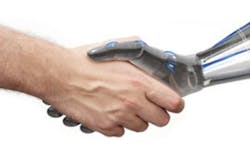Air Force asks for industry's help to enable autonomous vehicles to work together with humans
While this capability exists today, generally it is difficult, expensive, is designed one system at a time, and depends on where systems are located, Air Force experts say. Instead, researchers want to develop formal methods and mathematical frameworks to design autonomous and human-automation systems.
Machine autonomy experts at the Air Force Research Laboratory at Wright-Patterson Air Force Base, Ohio, have released a broad agency announcement (BAA-2014-0005-RQKPC for the Formal Mission Specification and Synthesis Techniques program.
This program not only seeks to develop standardized frameworks for developing autonomous systems for military applications, but it also is attempting to find ways to help humans collaborate with autonomous systems on complicated missions involving several different tasks.
Air Force leaders expect to increase their use of autonomous and human-automation systems in the coming decades, yet before they can do this need to develop methods quickly and reliably to design autonomous systems, researchers.
For human-automation systems -- or those that blend human operators and machine autonomy -- researchers need to develop ways to improve human-automation collaboration and increase human trust in automation.
Current methods for autonomous system design and implementation are relatively ad hoc, which makes it difficult to develop standard analysis and verification techniques, researchers explain.
Furthermore, autonomous systems are capable of a wide variety of complex behaviors that often depend on the environment in which they operate. For such systems, traditional test-based verification is time-consuming, expensive, and unreliable in the sense that it is extremely difficult to guarantee that the test cases cover all possible system behaviors.
One way to address these problems is to use rigorous mathematically based languages, tools, and techniques that provide standardized frameworks for system specification, design, and verification, researchers say.
Researchers have been trying to come to grips with these challenges, and have come up with approaches that include formal methods to synthesize correct-by-construction software and hardware, which for autonomous vehicles requires continuous dynamics and discrete decision-making.
From industry, Air Force researchers are asking for theoretical frameworks for expressing mission goals and limitations as formal system specifications; and using formal specifications to synthesize correct-by-construction protocols, decision-making procedures, or task execution plans.
These factors must consider system dynamics, system capabilities, adversaries, environmental factors, erroneous or missing information, or human operator preferences.
Researchers also would like to apply model-based design to improve autonomous performance and reliability; decompose problems to limit computational complexity; and enable better collaboration between the autonomous systems and human operators.
One way of doing this, for example, might be allow the operator to choose from several different mission plans, querying the operator, learning operator preferences,adding operator cognitive models, creating a task specification language to enable the operator to direct the autonomous vehicles, enabling the unmanned vehicles to tell the operate how good a job they are doing.
The Formal Mission Specification and Synthesis Techniques program has four parts: synthesis of control protocols for mission planning; human-automation mission planning; synthesis of infeasible or unrealizable specifications; and synthesis with learning-based adaptation.
Synthesis of control protocols for mission planning will develop a formal, mathematically based framework for multi-vehicle mission specification, planning, and execution. Human-automation mission planning will add human operators to the mix.
Synthesis of infeasible or unrealizable specifications will enable the system to work with ambiguity, and synthesis with learning-based adaptation will enable autonomous systems and humans working together to learn from their mistakes.
Air Force researchers say they will choose one contractor and spend about $1 million on this program. Companies interested should send proposals by post no later than 28 April 2014 to the Air Forces's Stephannie Siembab, AFRL/RQKPC, 2310 8th Street, WPAFB, OH 45433-7801.
For technical questions contact Laura Humphrey by phone at 937-713-7032, or by email at [email protected]. For contracting questions contact Stephannie Siembab by phone at 937-255-0340, or by email at [email protected].
More information is online at https://www.fbo.gov/spg/USAF/AFMC/AFRLWRS/BAA-2014-0005-RQKPC/listing.html.
